You are using an out of date browser. It may not display this or other websites correctly.
You should upgrade or use an alternative browser.
You should upgrade or use an alternative browser.
croissantking
- Joined
- Last seen
- · Viewing thread Combating SE / SE30 voltage drop
- Messages
- 2,718
- Reaction score
- 186
Profile posts Latest activity Postings About
-
Does anyone else think OPTi 'Firelink' is misleading and just a bit off? I mean, it implies it could be a Firewire chip.
 croissantking@zigzagjoe I thought remarking usually is to disguise a lower speed grade as a faster one, or one with fewer features as having more - not relevant for this USB controller?
croissantking@zigzagjoe I thought remarking usually is to disguise a lower speed grade as a faster one, or one with fewer features as having more - not relevant for this USB controller?
If the chips work, and identify as 82c861, then would it matter if they were remarked? zigzagjoeI'm given to understand it is more often cosmetics. Customers want new looking part not scratched up salvaged parts rather than malicious intent.
zigzagjoeI'm given to understand it is more often cosmetics. Customers want new looking part not scratched up salvaged parts rather than malicious intent.
For these I concur if it functions correctly then it's not really a huge concern, just good to know. croissantking@zigzagjoe they passed the acetone test
croissantking@zigzagjoe they passed the acetone test Renegadeit seems to me that many enablers implement this functionality under 7.1
Renegadeit seems to me that many enablers implement this functionality under 7.1 croissantkingIt is an ugly dialog box for sure! Probably made by an engineer not a designer. Still, interesting to see the progression towards the 7.5+ shutdown box we all know and loveI’m hoping to save this 040 chip, soldered to one of @zigzagjoe’s QFP2PGA boards. I ground two corners with a Dremel to be able to attach repair wires to the missing pins, which were lost to corrosion. Might give you some ideas for yours @jmacz
croissantkingIt is an ugly dialog box for sure! Probably made by an engineer not a designer. Still, interesting to see the progression towards the 7.5+ shutdown box we all know and loveI’m hoping to save this 040 chip, soldered to one of @zigzagjoe’s QFP2PGA boards. I ground two corners with a Dremel to be able to attach repair wires to the missing pins, which were lost to corrosion. Might give you some ideas for yours @jmacz
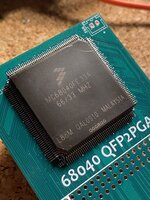
 jmaczNice, haven’t played with the chips yet but will try to save that one with the broken pin.
jmaczNice, haven’t played with the chips yet but will try to save that one with the broken pin. Joopmaccool, what about this adapter? is this an accelerator or just adapter? looks sweet.. is there a topic?
Joopmaccool, what about this adapter? is this an accelerator or just adapter? looks sweet.. is there a topic? croissantking@Joopmac its an adapter that lets you use a quad flat pack 040 in a PGA socket, designed by @zigzagjoe. It’s freely available on his GitHubMy SE/30s are very ill. Stock PSU issues, mostly. They’re recapped, but their +5V rails are too low. I might try tweaking the voltage pot - but +12V is already quite high.
croissantking@Joopmac its an adapter that lets you use a quad flat pack 040 in a PGA socket, designed by @zigzagjoe. It’s freely available on his GitHubMy SE/30s are very ill. Stock PSU issues, mostly. They’re recapped, but their +5V rails are too low. I might try tweaking the voltage pot - but +12V is already quite high. croissantkingAs I recall, anecdotally, they got worse after recapping. The big cap is a slightly different capacitance than the original, I hope that didn’t mess things up.
croissantkingAs I recall, anecdotally, they got worse after recapping. The big cap is a slightly different capacitance than the original, I hope that didn’t mess things up. robin-foI didn‘t change the big cap..
robin-foI didn‘t change the big cap.. croissantkingHave you played with the pot yet? I’ve been putting it off as it’s a fiddle to do, but I need to try.
croissantkingHave you played with the pot yet? I’ve been putting it off as it’s a fiddle to do, but I need to try. DaniëlThe Yosemite schematic says J18 should be a test point for the 14MHz clock going to the IMI SG500 clock generator, so the silkscreen for a supposed USB port seems unrelated. There is mention of a removed internal USB port during the prototype phase in the schematic changelog, so it may just be orphaned silkscreening for that.
DaniëlThe Yosemite schematic says J18 should be a test point for the 14MHz clock going to the IMI SG500 clock generator, so the silkscreen for a supposed USB port seems unrelated. There is mention of a removed internal USB port during the prototype phase in the schematic changelog, so it may just be orphaned silkscreening for that. croissantkingThat’s interesting!
croissantkingThat’s interesting! wthwwThis is extremely cool. The only way it could be better is if it was a molar
wthwwThis is extremely cool. The only way it could be better is if it was a molar jovianartifactthis probably wouldn't work with a sonnet G4 because the card itself sets multipliers, right? i wanna try and squeeze some more juice out of this beige beast hahaI want a PM6100 now.
jovianartifactthis probably wouldn't work with a sonnet G4 because the card itself sets multipliers, right? i wanna try and squeeze some more juice out of this beige beast hahaI want a PM6100 now. croissantking@Snial I wonder how it’s doing it’s memory performance calculation.
croissantking@Snial I wonder how it’s doing it’s memory performance calculation. PowerbaseTheoretical maximum is one thing, i don't think I've ever seen even 200+ in Gauge Pro. I'm unsure what it's using to calculate either.
PowerbaseTheoretical maximum is one thing, i don't think I've ever seen even 200+ in Gauge Pro. I'm unsure what it's using to calculate either. stynx"moving memory" = moving from one memory address to another = 1/2 the speed. If you add latency (333) you can subtract at least 50% again. Then there is wait-states from the controller, CPU and software induced (read-write cycle ... maybe with crc-check). The potential 266MiB/s memory (moving) throughput will more likely be maximum of 133MiB/s. Typical is about 1MiB/s per MHz so 87MiB/s would be considered normal.
stynx"moving memory" = moving from one memory address to another = 1/2 the speed. If you add latency (333) you can subtract at least 50% again. Then there is wait-states from the controller, CPU and software induced (read-write cycle ... maybe with crc-check). The potential 266MiB/s memory (moving) throughput will more likely be maximum of 133MiB/s. Typical is about 1MiB/s per MHz so 87MiB/s would be considered normal. Snial@joshc : Well, you can relive it now! https://infinitemac.org/2001/Mac OS...&machine=iMac+G3+(233+Mhz)&screenSize=832x624
Snial@joshc : Well, you can relive it now! https://infinitemac.org/2001/Mac OS...&machine=iMac+G3+(233+Mhz)&screenSize=832x624
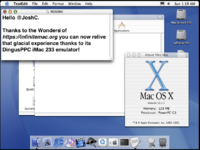
 SnialI tried it again on the Beige G3 emulator on Mac OS 10.1. Apple System Profiler reports a 63MHz G3! (can't be right, because it's usable). cc is there, but not gcc; no python, but there is javac. The precursor to Xcode is there. I was trying to find a benchtest, but couldn't.My PowerBook 165 keeps on finding new ways to piss me off. Now, it cold boots without sound or trackball/keyboard input. After doing a hard shutdown, and powering on again, it works normally. What in the hell… I’ve already replaced so many parts in this machine.
SnialI tried it again on the Beige G3 emulator on Mac OS 10.1. Apple System Profiler reports a 63MHz G3! (can't be right, because it's usable). cc is there, but not gcc; no python, but there is javac. The precursor to Xcode is there. I was trying to find a benchtest, but couldn't.My PowerBook 165 keeps on finding new ways to piss me off. Now, it cold boots without sound or trackball/keyboard input. After doing a hard shutdown, and powering on again, it works normally. What in the hell… I’ve already replaced so many parts in this machine. croissantkingYes @Snial I’m pretty determined to get it fully working.
croissantkingYes @Snial I’m pretty determined to get it fully working.
My 180 is better behaved.
Both are maxed out with rebuilt batteries.
I like having one of each type of greyscale screen (passive and active) with their relative pros and cons. SnialThe PB1xx series were special, because they revolutionised laptops. I had a PB100 (which I loved) until it got stolen when I accidentally left it in the foyer of the Kilburn building at Man Uni in 1998. I borrowed a PB150 for a couple of weeks a bit later (clunky, but cheap & had IDE drives).
SnialThe PB1xx series were special, because they revolutionised laptops. I had a PB100 (which I loved) until it got stolen when I accidentally left it in the foyer of the Kilburn building at Man Uni in 1998. I borrowed a PB150 for a couple of weeks a bit later (clunky, but cheap & had IDE drives). RetroTechTomMy 165 likes to reboot randomly when it feels like it
RetroTechTomMy 165 likes to reboot randomly when it feels like it croissantkingI found that one or more of the buffer chips was bad, but replaced them with wrong parts (too fast; overdriving inputs on other chips). Card worked for a while, but would crash upon resolution or bit depth change and sometimes displayed graphical corruption. After a while, the VCLK signal became unstable and I would lose sync, and now won't sync at all. Looking at VCLK output it wildly fluctuates between 0 and 8MHz.
croissantkingI found that one or more of the buffer chips was bad, but replaced them with wrong parts (too fast; overdriving inputs on other chips). Card worked for a while, but would crash upon resolution or bit depth change and sometimes displayed graphical corruption. After a while, the VCLK signal became unstable and I would lose sync, and now won't sync at all. Looking at VCLK output it wildly fluctuates between 0 and 8MHz. finkmachow'd you identify that the buffers were bad?
finkmachow'd you identify that the buffers were bad? croissantking@finkmac I just sort of guessed they might be given where they sit (between the Nubus interface and one of the ASICs) and it was easy to swap them.
croissantking@finkmac I just sort of guessed they might be given where they sit (between the Nubus interface and one of the ASICs) and it was easy to swap them. croissantkingMy caps have arrived for this
croissantkingMy caps have arrived for this DurosityOh my.. I hadn't even considered recapping my QT100! A write up would be pretty handy.
DurosityOh my.. I hadn't even considered recapping my QT100! A write up would be pretty handy. croissantkingIt’s coming soon - I’ve done the write up and assembled all the photos in a word doc. Just need to get my lazy ass to publish it.
croissantkingIt’s coming soon - I’ve done the write up and assembled all the photos in a word doc. Just need to get my lazy ass to publish it. SnialI had a friend whose Dragon 32 was connected to Prestel via a 1200/75 modem around 1984. In some ways it mirrors lots of Broadband performance. Prestel was based around the very weird GEC 4080, 16-bit minicomputer. It's mostly weird, because the Kernel is implemented in microcode! https://en.wikipedia.org/wiki/GEC_4000_series
SnialI had a friend whose Dragon 32 was connected to Prestel via a 1200/75 modem around 1984. In some ways it mirrors lots of Broadband performance. Prestel was based around the very weird GEC 4080, 16-bit minicomputer. It's mostly weird, because the Kernel is implemented in microcode! https://en.wikipedia.org/wiki/GEC_4000_series jmaczI've still got two 14.4 modems and a 28.8 connecting via a PBX. I probably have another modem around here somewhere -- actually like you I have an internal one in a PowerBook. I think my PBX can handle 6-8 lines. I should finish setting up my Hermes setup and then try having two other Macs dialed in at the same time. I don't remember if Hermes had any multi player door games.
jmaczI've still got two 14.4 modems and a 28.8 connecting via a PBX. I probably have another modem around here somewhere -- actually like you I have an internal one in a PowerBook. I think my PBX can handle 6-8 lines. I should finish setting up my Hermes setup and then try having two other Macs dialed in at the same time. I don't remember if Hermes had any multi player door games. SnialAt one level, the 68KMLA site is a BBS with hierarchical menus and articles. So, given the recent articles I've been reading about using FPGAs or fast MCUs to enable even lowly 8051s to handle elliptic-curve crypto I figure it's possible to design a PDS/NuBus/PCMCIA peripheral to offload the encryption and get BBS-ified, 68KMLA interaction
SnialAt one level, the 68KMLA site is a BBS with hierarchical menus and articles. So, given the recent articles I've been reading about using FPGAs or fast MCUs to enable even lowly 8051s to handle elliptic-curve crypto I figure it's possible to design a PDS/NuBus/PCMCIA peripheral to offload the encryption and get BBS-ified, 68KMLA interaction!
 croissantking@beachycove yes - two of those are functional - the Green SE/30 board and the 840AV board.
croissantking@beachycove yes - two of those are functional - the Green SE/30 board and the 840AV board. croissantkingOmg @beachycove I’m so slow! I just got your joke
croissantkingOmg @beachycove I’m so slow! I just got your joke
 HardwareHackerHey so you have a pair of boots then @croissantking @beachycove
HardwareHackerHey so you have a pair of boots then @croissantking @beachycove -
Loading…
-
Loading…
-
Loading…

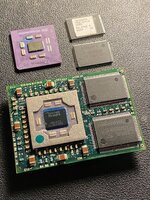
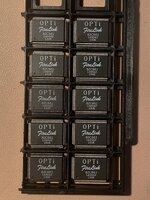
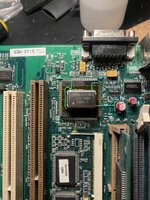



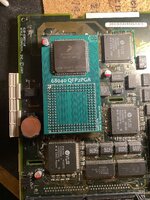

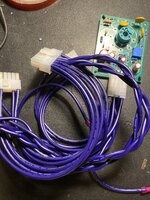
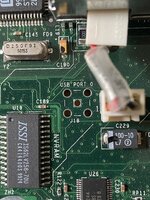
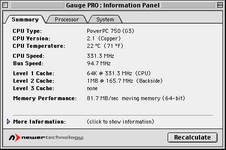

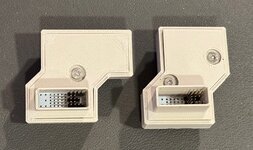
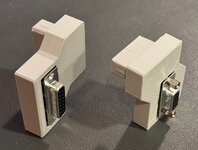
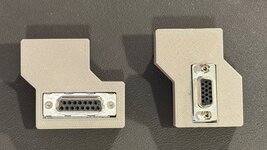

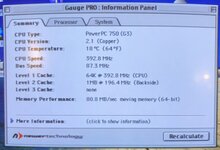
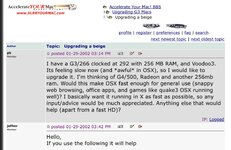
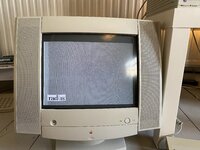
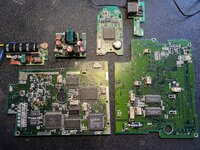
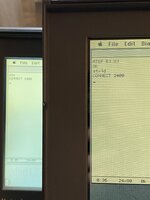
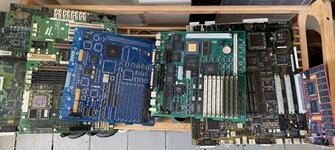


Reactions: croissantking